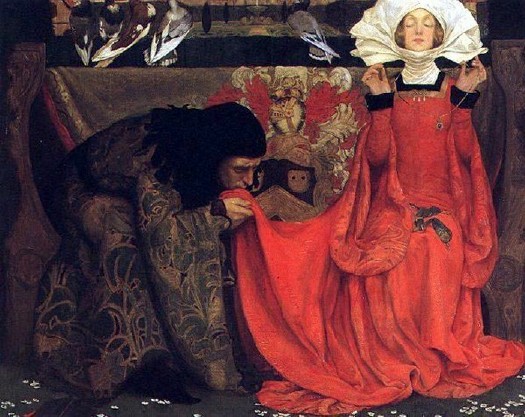How to Look at Art {Guest Post}
April 04, 2011Today I am happy to introduce Rosemary, who will be sharing some wonderful tips for appreciating artwork. :)
___________________________________
Hello, beautiful and talented readers of this blog! I am Rosemary (also known as R. A.), and I will be guest blogging here today! I have two blogs: { A True Word }, where I post poetry, and { The Daily Painting }, where in 2010 I posted a painting every day the whole year (I still update it, but not daily). And it is my love for art (specifically painting) that Shaylynn wants me to share with you today! I'm going to give you a quick lesson in how to look at/appreciate a painting. Here's my little disclaimer: I'm not an expert. I'm just a highschool girl who reads art criticism for fun. And the things you are about to read are just tips, not rules!
___________________________________
(Note from Shaylynn: Click each image to go to Rosemary's full post on each painting, and larger images).
READ THE TITLE. The first thing you should do is identify the subject matter and the title can be helpful. This may seem obvious, but titles can be easy to ignore. Even if the painting seems self explanatory, read the title! It could give the painting a whole different spin.
Especially if the title contains what sounds like an allusion. If it sounds like one, google it! It may give a new layer of meaning to the painting.
 |
| The Gift that is Better than Rubies, Eleanor Fortescue Brickdale |
The title might not always illuminate things though. Sometimes you'll have to work out the meaning for yourself.
Which leads us on to our next next tip . . .
LOOK. Really look at the painting. Look in the three distances: foreground, middleground, and background. Make sure you don't miss anything! It might be an important part of the story, or a symbol.
 |
| The Message, Thomas Cooper Gotch |
Which leads us on to our next next tip . . .
LOOK. Really look at the painting. Look in the three distances: foreground, middleground, and background. Make sure you don't miss anything! It might be an important part of the story, or a symbol.
 |
| Tristan and Isolde with the Potion, John William Waterhouse |
 |
| Virgin with Children. Filipino Lippi |
 |
| O Swallow, Swallow. John Melhuish Strudwick |
LOOK SOME MORE. Look at line, light, and color. Is the painting organized, or jumbled? How did the artist use light? What is the main color theme? How do all these elements make you feel, and why do they make you feel that way?
SPOT SYMBOLISM. In poetry, every word can be charged with meaning. In painting, everything can be. Recognizing symbolism is invaluable to understanding a painting. It opens up a world of meaning. Be sure to look for significance in the objects, colors, and placements in a painting. Try not to overdo it though. Sometimes a flower is just a flower (still, it’s nice to know what that flower could mean).
 |
| The Allotment Garden. Sir George Clausen |
 |
| St. George and the Dragon. Raphael |
 |
| Bonaparte, Calm on a Fiery Steed, Crossing the Alps. Jacques-Louis David |
 |
| Reverie. Marcus Stone |
 |
| Invocation. Lord Frederick Leighton |
SPOT SYMBOLISM. In poetry, every word can be charged with meaning. In painting, everything can be. Recognizing symbolism is invaluable to understanding a painting. It opens up a world of meaning. Be sure to look for significance in the objects, colors, and placements in a painting. Try not to overdo it though. Sometimes a flower is just a flower (still, it’s nice to know what that flower could mean).
 |
| Song of Love. Edward Burne-Jones |
Flowers and plants can carry the whole meaning of the painting.
Even very little things can take on symbolic meaning, like the tiny pair of scissors hanging from this girl's dress, continuing the theme of severance and perhaps making the farewell seem more final than it did before.
Pay attention to placement of people and objects.
BUT WHAT DOES IT MEAN? What was the artist trying to say about the subject? What was the artist’s purpose in painting this picture. Don't get frustrated if you can't answer those questions. Not all paintings have a purpose.
I encourage everyone to make an attempt to appreciate all art. Even if you don't like a painting, realize that someone did and try to see why. Some of the tips above can still apply to abstract paintings and help you appreciate them.
Now, I'm sure this post has kindled in you a new love and interest and art, and you are anxious to go and find more paintings to ogle and cherish! But where? Fear not! I am going to share with you a secret I have not shared with any other blog yet: my top websites for looking at and reading about art! And even if you're not quite that enamoured, I think you will find the following websites interesting!
Disclaimer: Just a warning, you might not like all the art you see and I can't vouch for all the material on these websites. Be careful as you surf!
www.artrenewal.org
The Art Renewal Center is dedicated to creating the largest online museum, to promoting a return of training, standards and excellence in the visual art, and more. Their website has a wealth of images, and also a lot of great info, like essays and FAQ about art (Some I found especially helpful were their articles on the difference between bad art and good art).
www.artmagick.com
"Your source of visual intoxication." How true! This website has an online museum like ARC, but it is much smaller and the focus is on Symbolist and Pre Raphaelite art. The quality of the reproductions is not always as good as ARC's, but Artmagick had the incredibly useful idea of organizing their artwork by "themes": http://www.artmagick.com/pictures/themes.aspx You can look only at art related to fairies, Arthurian mythology, or even only at paintings featuring brunettes! Plus, you have the option of saving your favorite paintings into "art albums!" http://www.artmagick.com/albums/
www.victorianweb.org
The ultimate source for all things Victorian! They have info on everything you can think of, and also a section just for the visual arts: http://www.victorianweb.org/art/index.html They have biographies of artists, a selection of their drawings and paintings, and sometimes information on individual paintings (like contemporary opinions and quotes).
www.wikipedia.org
Don't laugh. Wikipedia has some great entries on works of art! If you're puzzling over the symbolism in a painting, wikipedia may be able to help. But as usual, use with caution.
http://thedailypainting.blogspot.com/2010/01/christ-in-house-of-his-parents.html
www.thedailypainting.blogspot.com
This is my humble art blog. Not daily anymore, but there are still over 365 paintings (sometimes accompanied by fun facts or info) to look at. I’m always open to recommendations, and I love talking about art!
(Note from Shaylynn: Also check out the Google Art Project for some amazingly detailed photographs of paintings from museums around the world.)
I hope this article helped you to appreciate art more fully and I hope my writing wasn't too awful. Also, go buy some jewelry from Shaylynn! I have a charm bracelet from her shoppe and it is adorable. ;)
R. A.
Even very little things can take on symbolic meaning, like the tiny pair of scissors hanging from this girl's dress, continuing the theme of severance and perhaps making the farewell seem more final than it did before.
 |
| The Farewell. James Jacques Tissot |
 |
| The Madonna of the Meadow. Giovanni Bellini |
BUT WHAT DOES IT MEAN? What was the artist trying to say about the subject? What was the artist’s purpose in painting this picture. Don't get frustrated if you can't answer those questions. Not all paintings have a purpose.
I encourage everyone to make an attempt to appreciate all art. Even if you don't like a painting, realize that someone did and try to see why. Some of the tips above can still apply to abstract paintings and help you appreciate them.
Now, I'm sure this post has kindled in you a new love and interest and art, and you are anxious to go and find more paintings to ogle and cherish! But where? Fear not! I am going to share with you a secret I have not shared with any other blog yet: my top websites for looking at and reading about art! And even if you're not quite that enamoured, I think you will find the following websites interesting!
Disclaimer: Just a warning, you might not like all the art you see and I can't vouch for all the material on these websites. Be careful as you surf!
www.artrenewal.org
The Art Renewal Center is dedicated to creating the largest online museum, to promoting a return of training, standards and excellence in the visual art, and more. Their website has a wealth of images, and also a lot of great info, like essays and FAQ about art (Some I found especially helpful were their articles on the difference between bad art and good art).
www.artmagick.com
"Your source of visual intoxication." How true! This website has an online museum like ARC, but it is much smaller and the focus is on Symbolist and Pre Raphaelite art. The quality of the reproductions is not always as good as ARC's, but Artmagick had the incredibly useful idea of organizing their artwork by "themes": http://www.artmagick.com/pictures/themes.aspx You can look only at art related to fairies, Arthurian mythology, or even only at paintings featuring brunettes! Plus, you have the option of saving your favorite paintings into "art albums!" http://www.artmagick.com/albums/
www.victorianweb.org
The ultimate source for all things Victorian! They have info on everything you can think of, and also a section just for the visual arts: http://www.victorianweb.org/art/index.html They have biographies of artists, a selection of their drawings and paintings, and sometimes information on individual paintings (like contemporary opinions and quotes).
www.wikipedia.org
Don't laugh. Wikipedia has some great entries on works of art! If you're puzzling over the symbolism in a painting, wikipedia may be able to help. But as usual, use with caution.
http://thedailypainting.blogspot.com/2010/01/christ-in-house-of-his-parents.html
www.thedailypainting.blogspot.com
This is my humble art blog. Not daily anymore, but there are still over 365 paintings (sometimes accompanied by fun facts or info) to look at. I’m always open to recommendations, and I love talking about art!
(Note from Shaylynn: Also check out the Google Art Project for some amazingly detailed photographs of paintings from museums around the world.)
I hope this article helped you to appreciate art more fully and I hope my writing wasn't too awful. Also, go buy some jewelry from Shaylynn! I have a charm bracelet from her shoppe and it is adorable. ;)
R. A.







1 comments